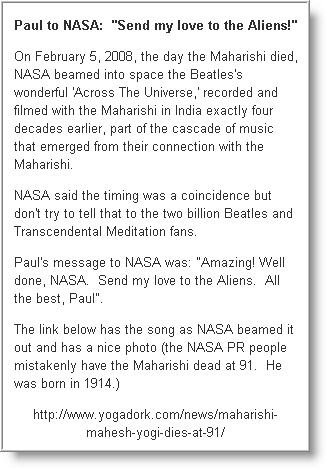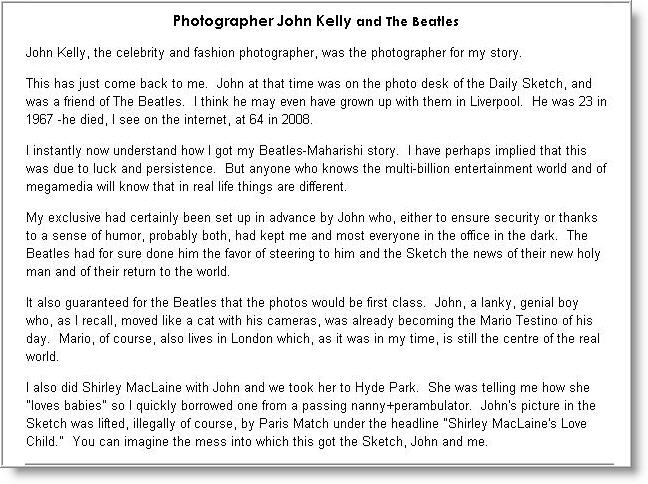Nicholas Asheshov, Editor of the Peruvian Times during the 1970s and 1980s, recalls how in the Swinging London of the 1960s Sir Paul McCartney, who plays in Lima on Monday 9, helped him to his first break. —-
I first met Paul McCartney in a Kensington drawing-room in 1967 when he was already world-famous. I was on Fleet St, a reporter trying to make my name in the man-bites-dog jungles of the world’s most ferocious newspapers, each of them great empires selling millions of copies.
Mine was the Daily Sketch, a bumptious right-wing tabloid owned by Lord Rothermere with headlines like “The Duke and Mandy -Palace Denial,” probably a story floated by the Sketch itself. This was the tough end of Fleet St and we were paid much better than the schoolmasters on The Times.
Paul had not been famous for long and I had not been on Fleet St for long. I was 26 and he was 24.
Over there by the window was, yes, Mick, 23, also becoming famous, and Marianne Faithfull, his lovely fair-haired pre-Bianca girlfriend, daughter of a European baroness and a British spy. Marianne was already, at 20, a top-of-the-pops star.
This was all a complete shock. I had gone along with a photographer to meet some obscure Hindu yogi. It was a sleepy London Sunday summer afternoon. Newspaper people call it the silly season because nothing happens.
As we went in the photographer whispered, smiling, “John. Paul. George. Ringo.” He said the names slowly, as if he were pulling rabbits out of a hat.
I was stunned. He pushed me forward.
The drawing-room had thick carpets, tall Georgian windows with heavy-draped curtains, and there was a hushed, respectful atmosphere unusual, I imagine, among super-stars. There were other showbiz people only some of whom I recognized, though of course the photogapher knew them all.
But the main point for me was not precisely that here were these world-famous fellow-youngsters but that they had been in hiding for months and I was the only journalist in the place. No one else had bothered to come to meet some old out-of-town holy man.
I will modify that only to enhance it. I had taken along with me Jane Gaskell, who shared a desk and a phone with me on the Sketch. Jane had become famous just a few years earlier as a 16-year-old best-selling author of soft-porn cavegirls-and-dinosaurs novels. She had long blond hair, long legs and very short skirts that were a feature of the cavernous newsroom overlooking the Thames, which half a century earlier had been a shipping warehouse. Jane was soon to go on to Hollywood and New York and was part of the new Swinging London.
This was a world where England’s tough young team had just beaten Germany at Wembley for the World Cup and where Christine Keeler, 20, had seduced the British Defence minister and, next evening, the Soviet military attaché, at Lord Astor’s house. Harold MacMillan’s government had tottered. Even the French were impressed.
After two world wars, hunger, and grey socialism it was suddenly OK to be young.
Myself, I knew more about the Amazon and Africa than about London. And here, suddenly, I was in this quiet star-packed nerve centre of the universe, alone with my note-book, a crack photographer and a micro-skirted girl novelist: finger-waves and air-kisses.
I had forgotten the Hindu. I went straight up to Paul –John looked less approachable– and whispered, “Nick, Sketch. What are you doing here?” Paul whispered in his thick, pleasant Liverpul twang, “We’ve come for a meditation lesson, I think. But it looks a bit crowded, doesn’t it.” I asked Ringo, “What’s happening?” “You tell me,” Ringo replies. “It’s supposed to be this holy man from Calcutta. Ask George, he knows.”
We were drinking tea out of china cups and here was the story: The Beatles had disappeared for months. Brian Epstein, their brilliant young manager, had committed suicide, for love of John, it transpired. The Beatles had also been had up before the magistrates for marijuana, a big deal in those days. They had gone underground.
But here they were and now they were producing a guru. Or as it turned out, it was the guru who was producing The Beatles.
According to my front-page smash scoop next day for an amazed Britain, the Hindu holy man was, Paul told the Daily Sketch and the world, “changing our lives.”
“We’re on a new track. We’re moving again.”
Forget Vietnam, Israel, the sterling crisis, Russia, the Bomb. This was real news.
My obscure Hindu was the Maharishi Mahesh Yogi and, once we were all seated, maybe 20 of us, in he came, a little chap in a straggly long grey beard and hair, parted down the middle, below his shoulders. We were all, starting with the Beatles, given flower rings to put around our necks.
Flower Power was born.
The Maharishi, as I recollect, sat cross-legged lotus-like on a cushion on the floor. He was then, I learn from the internet, 54, more than twice the age of anyone else in the room. This was the moment that the Maharishi launched Transcendental Meditation, TM. This was the beginning of a worldwide empire.
Thoughtfully, the Maharishi had already registered the trademark, Transcendental Meditation. The Mahashi, as The Beatles were allowed to call him, was “really important,” Paul told me. “He’s helping us a lot.” Indeed he was: within a few months they were to produce the epoch-making White Album.
“Meditating is so easy, so simple,” the Maharishi said in a light sing-song, and using an English that was long out-of-date in England: “Even a duffer can do it. Even Ringo can do it!” We laughed obsequiously. Ringo was of course no more of a duffer, in his field, than Maynard Keynes was in his, and even richer, although when later The Beatles all went to the Maharishi’s ashram he was the first to give up on the grounds that he was fed up with vegetable curry and wanted a steak and chips. One of the steadiest drummers in the business, he has also had a movie career. I remember him as the lecherous Mexican gardener in Candy, and the blind gun-slinger hero of a spaghetti western. I saw him on the TV last year for his 70th birthday and he looked just as sharp and pleasant as in that London drawing-room four decades ago.
I had a chat with Paul, then Ringo, a word with John and George. “He’s wonderful” – “He’s changing our lives, our music” and moved on to the Maharishi: The Holy Man Who is Saving The Beatles, as the Daily Sketch told the world next day.
He explained to me pleasantly, “John, Paul, George and Ringo are the most admired young people in the world. If they take up Transcendental Meditation, TM, the whole world will follow.
“These people are hard-working, supremely talented. But they are tempted into problems, like drugs. With TM they won’t want these things.”
I got the Maharishi to pose for the photographer in the plush drawing room talking into a white telephone: this was chosen, presciently, as the front-page photo for the next day.
My story in the morning appeared as a slam-bang front-page Exclusive! The Holy Man who is changing the lives of The Beatles by Sketchman Nicholas Asheshov.
The photo of the Maharishi on the phone was splashed over most of the front page.
 Inside, the whole centre spread was of the Beatles with the Maharishi, with quotes from everyone, with little photos of Marianne and Mick. Jane did a side-bar which started off with “The roses are back in The Beatles’s cheeks.”
Inside, the whole centre spread was of the Beatles with the Maharishi, with quotes from everyone, with little photos of Marianne and Mick. Jane did a side-bar which started off with “The roses are back in The Beatles’s cheeks.”
All over Britain grannies, mums and teen-agers sighed a little tear of relief and pleasure.
The Maharishi died a couple of years ago aged 94 with two billion pounds in his bank accounts. He had fallen out with the Beatles a year or two after our get-together in Kensington and had taken up with other stars of the day and was, famously, accused of trying to rape Mia Farrow. Within a few years of our meeting he had five million followers, the first wave of tens of millions more and his TM was established worldwide as a useful and, at worst, harmlessly peaceful pursuit.
Paul McCartney, Sir Paul, was and, as many of you will see in Lima on Monday, still is one of the great musicians and creative forces of our time.
It was an unlikely genetic event that brought together these four modest boys in a grimy post-war British port town. That Lennon and McCartney should be two of the great artistic talents of our time is another marvel. Those of you who have had the forethought to acquire tickets will get your money’s worth. You will see and hear a Master. And when it comes to putting on a show, as the billions who watched the Royal Wedding the other day saw yet again, the Brits are in a league by themselves.
Myself, I shall be in Urubamba as usual, but thinking, as I am now, of how those four boys and I chatted for a while in the room where flower power was launched by another genius, the Mahashi. He had had the courage, the vision, the timing and the chutzpah to grab hold of the four boys who could launch for him a worldwide spiritual movement about which we all know and which coined him a massive fortune. When he arrived at that house in Kensington, for all I know he got there by bus. When he died he had his own fleet of planes and helicopters. A few weeks before he died he announced, a trouper to the last, that “My work is done.” In a century of flannelers, an all-time great.
And, bless him, and Paul and the Beatles, he launched me out of the back of the pack. Next day at the office, battle-honed veterans of savage Fleet St wars would pass by with their mugs of tea and mutter kindly, “Good read, Nick.” Or at the pub later, a paunched, nicotined warhorse might offer a pint and growl, “Nice one, Nick.”
I was on my way.






